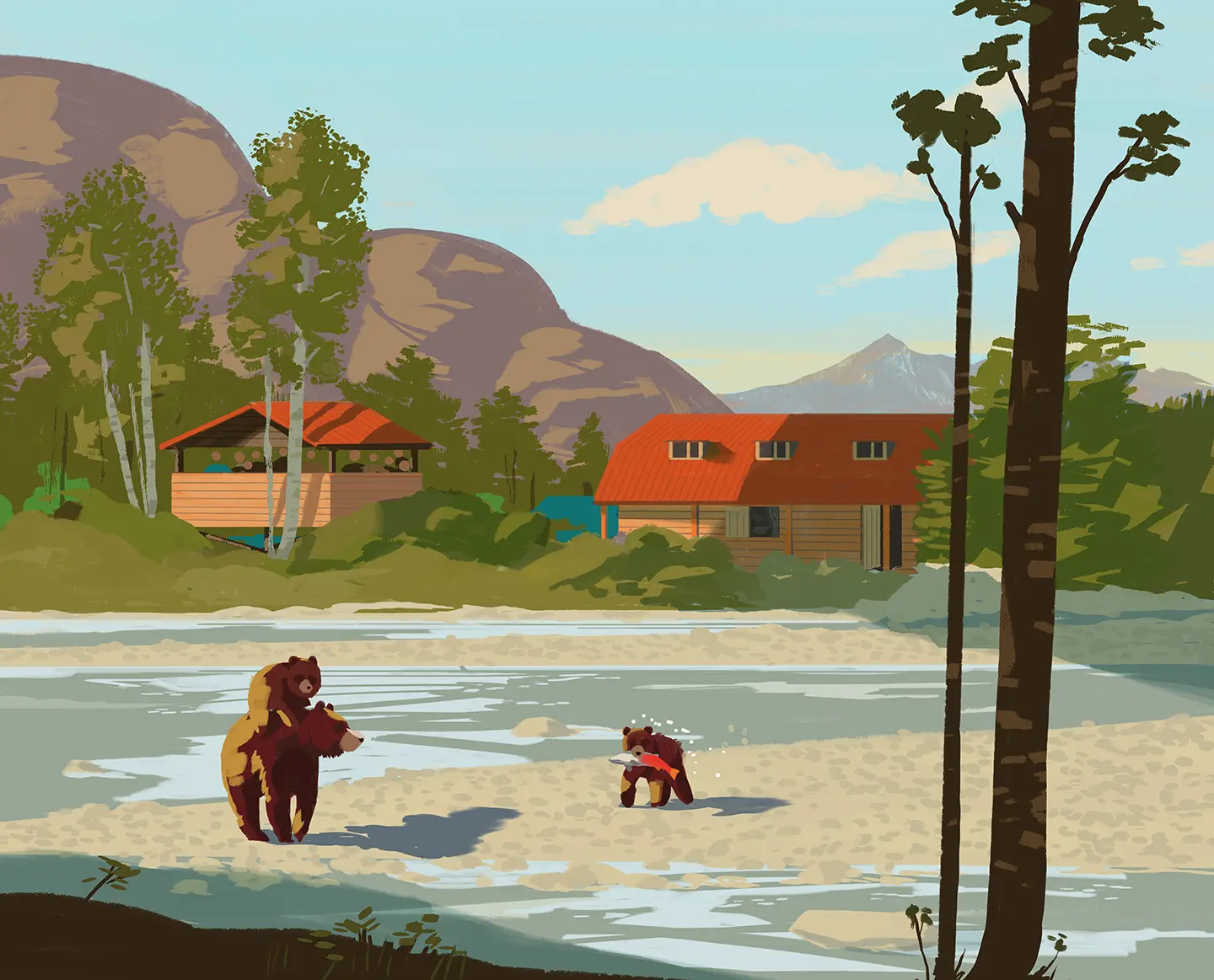Hiking through the lush meadow at the base of a mountain in the Hart Ranges, I paused, trying to sear the alpine view into my memory. With the mountain’s steep slope rising behind me, I looked out over sunlit fields of alpine pasque flower and yellow glacier lily. A shallow, tea-coloured kettle pond shimmered in the middle distance, its far bank bordered by a rocky ledge that dropped away to a meandering creek in the valley below. Flanked by a forest so flawless and densely green it looked like velvet, I found myself counting the glacier-fed waterfalls tumbling from the surrounding peaks into that nameless stream.
Then I heard my name called—I’d fallen behind. My group had climbed out of the meadow and reached a remnant patch of winter snow. The hardiest were boot-skiing and making snow angels.
Trail-less and five days on foot from the nearest road out of the remote town of Tumbler Ridge, British Columbia, we were crossing the kind of high alpine saddle you might glimpse from a plane window en route from Vancouver to somewhere distant. Cradled in a snow-capped fold of the northern Rockies, this was true backcountry. We’d flown in by helicopter for a meandering day hike—a luxury that felt indulgent until our pilot mentioned he was also monitoring for endangered caribou. We were in critical habitat, where conservation efforts were ongoing, and simply adding a few more eyes could make a difference.
In recent years, my work as a travel journalist has shifted into something a colleague recently described as “stories that encourage people to travel to the unpopular places.” Rather than being offended, I realized her description wasn’t far off. After years of trying to find clever new ways to entice people to vacation in overcrowded destinations, I’d grown disillusioned. The kind of overtourism I’d been promoting wasn’t just harming the planet and local communities—it wasn’t doing me any favours either. What I craved, and wanted to write about, was how travel used to make me feel—before I started chasing checkmarks on an arbitrary bucket list.
Then the pandemic hit. And when it became possible to travel again, with health rules mandating staying close to home, I booked a last-minute grizzly-viewing trip to Tweedsmuir Park Lodge on the Atnarko River.
Early on my first morning, I stood in a riverside blind with a small group of Canadians. We were swapping whispered stories about the cancelled plans that led us here—safaris, Italian getaways, long-dreamed-of cruises—when a mother bear and her gangly second-year cubs came around the bend. Staring into the gin-clear water, one cub made a comical, splashy leap into a pool filled with red-sided salmon and came up empty, shaking water off like a dog. The next cub had better luck, catching a fish and holding it clenched in its teeth while floating past its sibling. Behind them, the cloud-scraping peak that Alexander Mackenzie named Stupendous Mountain framed the scene. The three continued their lazy hunt, then vanished around the next bend in the river.
As we waited, hoping for another bear, our guide explained that while the current salmon run was strong, the previous year’s return was so poor it was unlikely we’d see any of the crowd-favourites: the fuzzily adorable first-year cubs. Because the Atnarko’s grizzly sows hadn’t consumed enough fat-rich salmon before hibernation, they wouldn’t have sustained a pregnancy.
Concerned about what else might affect the bears, I asked if our presence kept them from fishing and feeding during this critical period of hyperphagia. The guide didn’t answer directly. Instead, she led us down a trail to a small blind where researchers from the University of Victoria, the Nuxalk Nation, and BC Parks had a monitoring station. The Nuxalk Nation and BC Parks had raised the same questions, which spearheaded a study on the effects of eco-tourism on grizzlies.
That evening at dinner, we talked about what we’d learned. Preliminary research suggested that while dominant males avoid areas with tourists, young solo bears and females with cubs often seek these spots out. The theory is these more vulnerable bears use tourists as “human shields” because they’ve learned the big males avoid people. This means that by putting up with a few onlookers, the females can protect their cubs while accessing prime fishing spots.
Pleased we weren’t doing harm, one guest commented that she was thrilled to learn her unexpected trip to Tweedsmuir Park Lodge wasn’t just a remarkable wildlife viewing experience but might also be helping the grizzlies. She was surprised by how she’d developed a sense of responsibility for their well-being. Until that morning, she’d never seen a grizzly in person. Just a few weeks earlier, she hadn’t known the Atnarko River existed—or that falling in love with a landscape could turn her into someone who felt responsible for helping to safeguard its future.
When I think about the moments that reshaped my relationship with travel, Tweedsmuir Park Lodge stands out. It was one of those experiences that showed me how travel—when approached with care and curiosity—can forge a powerful connection to a place. And when that place is in your own backyard, that connection can quickly grow into a desire to help protect it.
By the time we reached Vancouver, my sense of identity as a Canadian had begun to shift—this time shaped not by textbooks but by first-hand experiences with the land and its people.
My Tweedsmuir experience reinforced something I’d learned on a Canadian trip years earlier. My husband, daughter, cat, and I had just reached the U.S.–Canada border between Maine and New Brunswick, at the start of a cross-country road trip after eight years of living abroad. The Canadian border agent peered into our overstuffed car, his stern expression making me worry he might ask us to unpack everything we owned. I was beginning to regret not skipping the extra hassle and flying home, when 15-month-old Maia piped up, telling him we were on a “coming-home-to-Canada car ride!”
The agent’s mood shifted, and he welcomed us home. He asked where we were headed and what we hoped to see, and shared a few favourite stops on his home island of Cape Breton. Over the next few weeks, I found myself captivated by scenes pulled straight from my elementary school geography books: the rocky shores of Nova Scotia, the winding cobblestone streets of Quebec City, the shimmering foliage of the Canadian Shield, the unexpected diversity of the Prairie grasslands, and the sheer majesty of the Rockies. By the time we reached Vancouver, my sense of identity as a Canadian had begun to shift—this time shaped not by textbooks but by first-hand experiences with the land and its people.
I’d also developed an insatiable curiosity about our country and wanted to know how experiencing more of our remarkable land might deepen my understanding of what it means to be Canadian. But before I could explore that pull, my work steered me back to the well-trodden destinations favoured by travel magazines—and by editors who hadn’t yet ventured to places like Nunavut’s Diana Island, where an Inuk guide might share jokes as you follow muskox across windswept tundra, or Manitoba, where the Bloodvein River slices through the boreal forests of the ancient Canadian Shield and you can paddle past a street sign for an ice road, or Tumbler Ridge, where you can brush away sand from nearly million-year-old theropod tracks.
But unexpectedly, just as I was revelling in the sense of reconnection I’d found in Tweedsmuir, I learned the pandemic was continuing to steer Canadians to travel within our own country—and I wanted to be part of that movement.
I finally got the chance to focus my career on things such as floating through the mist at Niagara Falls, travelling by train to Jasper, strolling the vibrant summer streets of Montreal, sipping wine drawn straight from the barrel in Kelowna, watching for belugas on the St. Lawrence, and marvelling at a sun that never set in the Yukon. I discovered I was more hopelessly hooked on Canada than ever. I was now the kind of person who said things like “I think Quebec does France better than France” and “Why go to Iceland for the northern lights? Eighty to 90 percent of the accessible land inside the auroral oval is in Canada.”
Each trip deepened my sense of wonder—and reminded me how much I still had to learn about my own country and the people I share it with. Boating down the Yukon River to the Huchá Hudän / Fort Selkirk historic site carried me through the story of the gold rush and offered a glimpse into the rich culture of the Northern Tutchone people—including how to harvest soapberries and whip them into a frothy, astringent treat known as Indian ice cream. Road-tripping through Newfoundland brought me face to face with moose, whales, and icebergs—and taught me that most icebergs began as snowflakes in Greenland’s glaciers, slowly compacting into ice before breaking off into the sea thousands of years later. Experiencing the thundering return of bison to the grasslands around Métis Crossing in Alberta made my heart clench and my eyes sting with tears, deepening my commitment to reconciliation.
At the base of the Hart Ranges mountain, I stopped counting waterfalls and hiked up out of the meadow. The breeze felt clean and snow-cooled and carried a grassy scent. A repeated bird trill—sharp and shrill—cut across the ridge, and I wondered if it was a warning. Reaching my group, I joined them at the edge of a cliff to take in the view of a pristine lake below. Then, a sudden gust of wind lifted one member’s hat, and we watched in quiet dismay as it sailed out of reach, settling far below. In that moment, the remote setting felt forever altered by our presence.
Read more from our Autumn 2025 issue.









